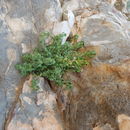Comments
provided by eFloras
Some extremes of Parietaria pensylvanica with short, oblong or ovate leaf blades strongly resemble P . hespera var. hespera . Parietaria hespera is usually more delicate and has thinner leaves with the proximal pair of lateral veins arising at the junction of blade and petiole. Leaf shape and texture tend to overlap in the two species, but in P . pensylvanica the proximal pair of lateral veins clearly arise above the junction of blade and petiole. The extremes of P . pensylvanica frequently are found where the ranges of the two species approach or overlap. Examples of these intermediates are from Gila, Mohave, and Yuma counties, Arizona. A mixed collection from Rock Springs, Gila County, Arizona, suggests that the two species occasionally grow together.
- license
- cc-by-nc-sa-3.0
- copyright
- Missouri Botanical Garden, 4344 Shaw Boulevard, St. Louis, MO, 63110 USA
Description
provided by eFloras
Herbs , annual, 0.4-6 dm. Stems simple or freely branched, decumbent, ascending, or erect. Leaf blades narrowly to broadly elliptic, lanceolate, oblong, or ovate, (1-)2-9 × 0.4-3 cm, base narrowly cuneate, apex acuminate to long-attenuate or obtuse to rounded; proximal pair of lateral veins arising above junction of blade and petiole. Flowers: involucral bracts 1.8-5 mm, usually less than 2 times length of achene; tepals 1.5-2 mm, shorter than bracts. Achenes light brown, symmetric, 0.9-1.2 × 0.6-0.9 mm, apex obtuse, mucro apical; stipe straight, short-cylindric, centered, basally dilated. 2 n =14, 16.
- license
- cc-by-nc-sa-3.0
- copyright
- Missouri Botanical Garden, 4344 Shaw Boulevard, St. Louis, MO, 63110 USA
Distribution
provided by eFloras
Alta., B.C., Man., Ont., Que., Sask., Yukon; Ala., Ariz., Ark., Calif., Colo., Conn., D.C., Fla., Ga., Idaho, Ill., Ind., Iowa, Kans., Ky., La., Maine, Md., Mass., Mich., Minn., Miss., Mo., Mont., Nebr., Nev., N.H., N.J., N.Mex., N.Y., N.C., N.Dak., Ohio, Okla., Oreg., Pa., S.C., S.Dak., Tenn., Tex., Utah, Vt., Va., Wash., W.Va., Wis., Wyo.; Mexico.
- license
- cc-by-nc-sa-3.0
- copyright
- Missouri Botanical Garden, 4344 Shaw Boulevard, St. Louis, MO, 63110 USA
Flowering/Fruiting
provided by eFloras
Flowering spring-late fall.
- license
- cc-by-nc-sa-3.0
- copyright
- Missouri Botanical Garden, 4344 Shaw Boulevard, St. Louis, MO, 63110 USA
Habitat
provided by eFloras
Dry ledges, talus slopes, waste and shaded places, primarily in neutral to basic soils, and reported from margins of hot springs in northernmost locations; 0-2400m.
- license
- cc-by-nc-sa-3.0
- copyright
- Missouri Botanical Garden, 4344 Shaw Boulevard, St. Louis, MO, 63110 USA
Synonym
provided by eFloras
Parietaria obtusa Rydberg ex Small; P.o ccidentalis Rydberg; P. pensylvanica var. obtusa (Rydberg ex Small) Shinners
- license
- cc-by-nc-sa-3.0
- copyright
- Missouri Botanical Garden, 4344 Shaw Boulevard, St. Louis, MO, 63110 USA
Parietaria pensylvanica: Brief Summary
provided by wikipedia EN
Parietaria pensylvanica, commonly called Pennsylvania pellitory, is a species of flowering plant in the nettle family. It is native to much of North America including every province in Canada except the Maritimes and Newfoundland and Labrador, Yukon Territory, every state in the United States except Alaska and Hawaii, plus northern Mexico. It is typically found in circumneutral or basic soils, in natural habitats such as calcareous cliffs and barrens, and in rich floodplains. It is also found disturbed areas.
It is an annual herb growing decumbent or erect to a maximum height near half a meter. The alternately arranged leaves are lance-shaped or oval with a pointed tip and measure up to 3 centimeters in length. The inflorescence is a cluster of flowers emerging from the leaf axils. The flower lacks petals but it has tiny pointed reddish brown sepals.

Detail of inflorescence
- license
- cc-by-sa-3.0
- copyright
- Wikipedia authors and editors


